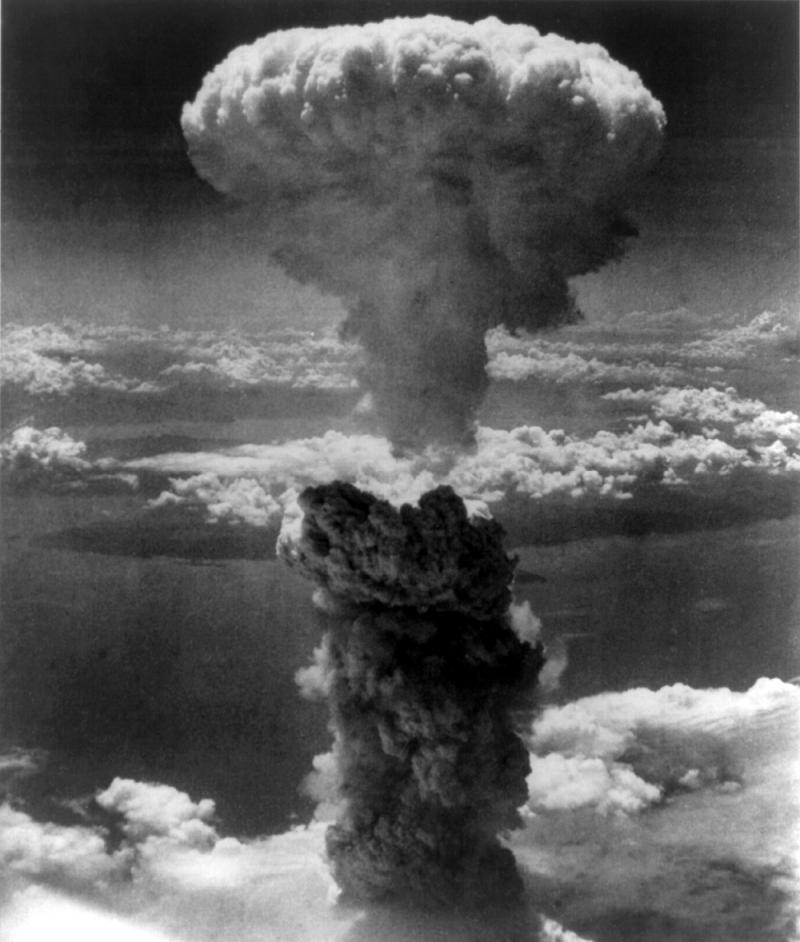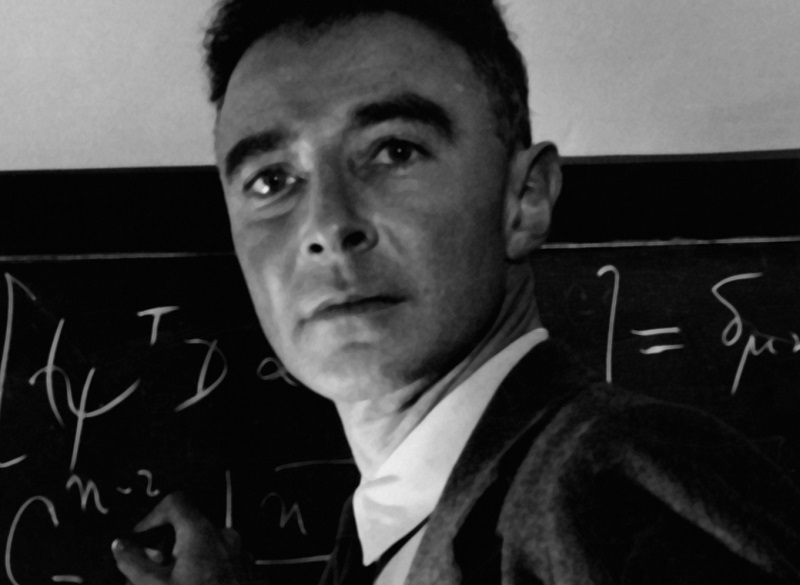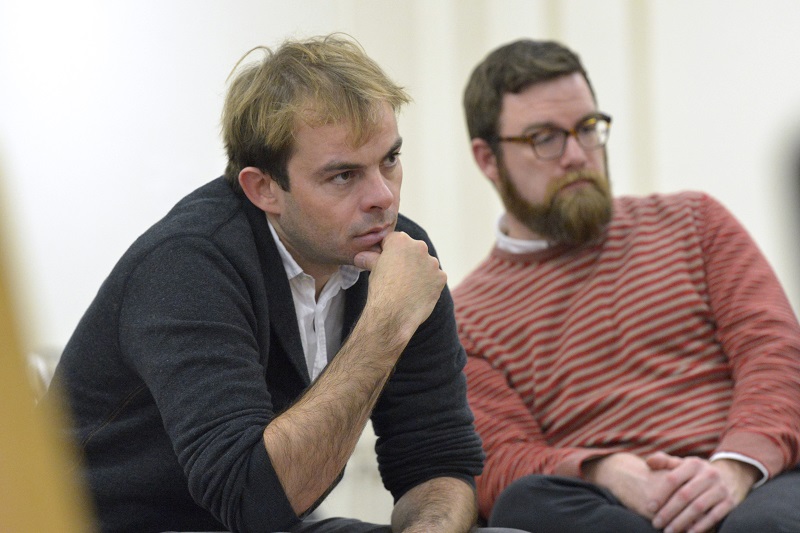First Person: Finding Oppenheimer | reviews, news & interviews
First Person: Finding Oppenheimer
First Person: Finding Oppenheimer
The author of the RSC's new play about the creator of atomic bomb seeks an elusive truth

That the truth will always be so much bigger than we can comprehend is something I had to accept as I started to write Oppenheimer. There are so many sources, so much information, so many hundreds of books, declassified files, interviews and history. One biography of the man took its authors 25 years to write. And there are still the hidden thoughts that were never written down, conversations long forgotten by people now long dead.
Artists and writers return to the story of Robert Oppenheimer, and indeed the entire Manhattan Project, because it functions as a creation myth for the modern world. The bombings of Hiroshima and Nagasaki can be seen as the first acts of the Cold War – a posturing of power towards the Russians. In the treatment of Oppenheimer we can see the seeds of McCarthyism and the anti-Communist hysteria that came to define the 1950s. The surveillance culture that became so prominent throughout the second half of the 20th century, and continues to this day, can be traced back to those laboratories in Berkeley and New Mexico.

There is a concept in quantum theory known as complementarity. It was developed by Niels Bohr, one of the founding fathers of quantum mechanics (and a character in Michael Frayn’s Copenhagen). Put simply, it is the idea that two scientists, researching the same phenomena, could come to two entirely opposite, yet equally true, conclusions. It is perfectly reasonable for one scientist to conclude that light is made up of particles, for example, while the other discovers that light is constructed of waves – both answers are demonstrably true, neither are adequate. (Pictured below: director Angus Jackson with, right, playwright Tom Morton-Smith. Photograph by Keith Pattison)
 In the play I use this idea to explain how it is possible that the Nazi atomic bomb programme never developed beyond some designs for a nuclear reactor, while the US and British project created the most devastating weapon that had ever been known. Both teams were working on the same problem, both projects boasted geniuses amongst their number - only one succeeded.
In the play I use this idea to explain how it is possible that the Nazi atomic bomb programme never developed beyond some designs for a nuclear reactor, while the US and British project created the most devastating weapon that had ever been known. Both teams were working on the same problem, both projects boasted geniuses amongst their number - only one succeeded.
The truth is huge and can never be captured, or even comprehended – in the same way that you will never be able to explain the internet to a cat. But glimpses of truth, glimpses of ideas and thoughts – these go some way to helping us to understand the world. The human brain is remarkable when it comes to joining the dots and filling in the gaps. I hope there are enough glimpses of the Manhattan Project, of Oppenheimer and of that horrific but arguably necessary weapon to make my play sufficiently thought-provoking and maybe even close to telling some small part of truth.
Share this article
The future of Arts Journalism
You can stop theartsdesk.com closing!
We urgently need financing to survive. Our fundraising drive has thus far raised £49,000 but we need to reach £100,000 or we will be forced to close. Please contribute here: https://gofund.me/c3f6033d
And if you can forward this information to anyone who might assist, we’d be grateful.

Subscribe to theartsdesk.com
Thank you for continuing to read our work on theartsdesk.com. For unlimited access to every article in its entirety, including our archive of more than 15,000 pieces, we're asking for £5 per month or £40 per year. We feel it's a very good deal, and hope you do too.
To take a subscription now simply click here.
And if you're looking for that extra gift for a friend or family member, why not treat them to a theartsdesk.com gift subscription?
more Theatre
 The Weir, Harold Pinter Theatre review - evasive fantasy, bleak truth and possible community
Three outstanding performances in Conor McPherson’s atmospheric five-hander
The Weir, Harold Pinter Theatre review - evasive fantasy, bleak truth and possible community
Three outstanding performances in Conor McPherson’s atmospheric five-hander
 Dracula, Lyric Hammersmith review - hit-and-miss recasting of the familiar story as feminist diatribe
Morgan Lloyd Malcolm's version puts Mina Harkness centre-stage
Dracula, Lyric Hammersmith review - hit-and-miss recasting of the familiar story as feminist diatribe
Morgan Lloyd Malcolm's version puts Mina Harkness centre-stage
 The Code, Southwark Playhouse Elephant review - superbly cast, resonant play about the price of fame in Hollywood
Tracie Bennett is outstanding as a ribald, riotous Tallulah Bankhead
The Code, Southwark Playhouse Elephant review - superbly cast, resonant play about the price of fame in Hollywood
Tracie Bennett is outstanding as a ribald, riotous Tallulah Bankhead
 Reunion, Kiln Theatre review - a stormy night in every sense
Beautifully acted, but desperately grim drama
Reunion, Kiln Theatre review - a stormy night in every sense
Beautifully acted, but desperately grim drama
 The Lady from the Sea, Bridge Theatre review - flashes of brilliance
Simon Stone refashions Ibsen in his own high-octane image
The Lady from the Sea, Bridge Theatre review - flashes of brilliance
Simon Stone refashions Ibsen in his own high-octane image
 Romans: A Novel, Almeida Theatre review - a uniquely extraordinary work
Alice Birch’s wildly epic family drama is both mind-blowing and exasperating
Romans: A Novel, Almeida Theatre review - a uniquely extraordinary work
Alice Birch’s wildly epic family drama is both mind-blowing and exasperating
 The Producers, Garrick Theatre review - Ve haf vays of making you laugh
You probably know what's coming, but it's such great fun!
The Producers, Garrick Theatre review - Ve haf vays of making you laugh
You probably know what's coming, but it's such great fun!
 Not Your Superwoman, Bush Theatre review - powerful tribute to the plight and perseverance of Black women
Golda Rosheuvel and Letitia Wright excel in a super new play
Not Your Superwoman, Bush Theatre review - powerful tribute to the plight and perseverance of Black women
Golda Rosheuvel and Letitia Wright excel in a super new play
 Cow | Deer, Royal Court review - paradox-rich account of non-human life
Experimental work about nature led by Katie Mitchell is both extraordinary and banal
Cow | Deer, Royal Court review - paradox-rich account of non-human life
Experimental work about nature led by Katie Mitchell is both extraordinary and banal
 Deaf Republic, Royal Court review - beautiful images, shame about the words
Staging of Ukrainian-American Ilya Kaminsky’s anti-war poems is too meta-theatrical
Deaf Republic, Royal Court review - beautiful images, shame about the words
Staging of Ukrainian-American Ilya Kaminsky’s anti-war poems is too meta-theatrical
 Laura Benanti: Nobody Cares, Underbelly Boulevard Soho review - Tony winner makes charming, cheeky London debut
Broadway's acclaimed Cinderella, Louise, and Amalia reaches Soho for a welcome one-night stand
Laura Benanti: Nobody Cares, Underbelly Boulevard Soho review - Tony winner makes charming, cheeky London debut
Broadway's acclaimed Cinderella, Louise, and Amalia reaches Soho for a welcome one-night stand
 The Pitchfork Disney, King's Head Theatre review - blazing with dark energy
Thrilling revival of Philip Ridley’s cult classic confirms its legendary status
The Pitchfork Disney, King's Head Theatre review - blazing with dark energy
Thrilling revival of Philip Ridley’s cult classic confirms its legendary status

Add comment